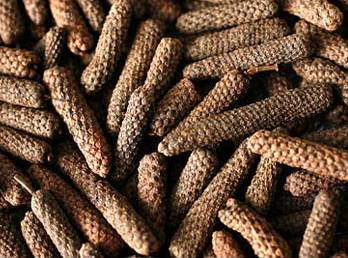Indian long pepper (Tippili)
Piper longum Lin
Piperaceae
Varieties
The important varieties for cultivation are Vellanikara -1 (Visvum Tippili) and Yercaud (Pl)-9.
Soil and Climate
The well drained red, loamy soils rich in organic matter (humus) are suited for cultivation. Lower elevations with high humidity are best suited for cultivation. It thrives well in regions having 30 – 32 °C temperature, 60 % humidity with annual rainfall of 150 cm.
Seed and sowing
It can be propagated through rooted cuttings.

|
Rooted cuttings |
Spacing
Hills : 2 x 2 m
Plains : 60 x 30 cm
In plain conditions, cultivation can be taken under coconut or arecanut plantations while in hilly areas, it can be planted as intercrop in between banana or casuarinas trees. To prevent from excess temperature during late afternoon, shade trees like dadaps and banana can be planted. Some of the wide spreaded branches may be trimmed once in a year for maintaining the shade.
Season
The planting is distributed from June – July and September – October
Planting
Planting can also be taken in coconut and arecanut plantations in multitier cropping pattern. Pits of 15 cm depth are formed and the rooted cuttings are planted at the center of pit.
Irrigation
Irrigation is done at weekly intervals.
Manuring
Incorporate 20 – 25 (plains) and 10 t/ha (hills) of FYM
After cultivation
Weeding followed by earthing up is required up to 3 months. Dry leaves are used as mulches. Annually trim the shade trees to ensure adequate shade. Additional shade requirement in arecanut gardens can be provided by planting banana.
Plant protection
Leaf spot
During rainy seasons spray Mancozeb 2g/lit of water.
Harvest
Harvesting can be done when fruits attain the dark green colour. The crop can be maintained up to three years.

Dried pods
Yield
First year - 750 kg dried fruits/ha
Second year - 1500 kg dried fruits/ha
Source
1. http://cookingbuddies.com/osc/images/LongPepper.jpg
|


